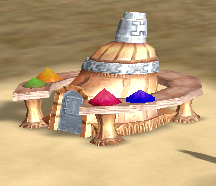The Wiki for Tale 4 is in read-only mode and is available for archival and reference purposes only. Please visit the current Tale 11 Wiki in the meantime.
If you have any issues with this Wiki, please post in #wiki-editing on Discord or contact Brad in-game.
Portable Star Lab
Portable Star Labs are the method by which new stars may be discovered, for use in the Test of Pyrotechnics. Each university starts with the same two basic recipes, and can gain additional ones using Star Labs. Each university that has opened the Pyrotechnics technology will distribute approximately two Portable Star Labs to players per week, apparently at random intervals. After use, a lab can be turned in at any University that has opened Pyrotechnics (note: not necessarily the one from which it was received). Once a single university has received seven labs, the scientists there, also known as a random number generator, will select one of the seven submitted stars, and players will then be able to learn that recipe from that university, and only that university.
Star labs are pre-loaded with materials to fire 60 shots. After each shot, the owner is given the option of naming the shot that was just fired, selecting the shot that was just fired as the best so far, refiring the last shot without changing it, or firing a new random shot. Players other than the owner can register as watchers of the display, and will be able to see the stars as they are launched, and read the costs of the most recently-launched star. The owner of the lab has sole discretion over which star is selected as the "best" - it is not a voting process - but typically the owners solicit input from the watchers and make a collaborative decision. Once a final decision has been made and named, the lab can be turned in at a university. At this point, the number of watchers becomes important: this number is a weighting factor on how likely it is that that particular star design will be selected, once 7 total have been turned in. (Example: six labs are turned in with 1 watcher, and a seventh is turned in with 14 watchers. There will be a 70% chance that the seventh lab is the one selected)
Star labs seem to produce several basic kinds of stars: (not an exhaustive list yet)
- Pulsing stars - these have a strong glow on the first star, and usually leave a simple trail. There is considerable variability in the size of the star, and the length of the trail. The basic frog and canary designs are this type.
- Cone stars (comets) - Have a strong glow at the front, and diffuse into a short 'cone' shape.
- Bomb stars (poppers) - these are often hard to see, since they fly their lifetime unignited, and then explode at the end. Single poppers are useful as near-invisible platforms for delivering other stars, while showers of many poppers can be an impressive finale.
- Trails ("Thin Red Line") - long thin trails of light, often used for spirals and geometric shapes.
- Sparkler Stars - these are typically crowd favorites. They leave a shower of sparks as a trail, usually but not always in the same color as the head of the star.
Stars are typically a single basic color, but there are occasional instances of two-color stars. In some cases, both colors are present in the star, and in others, the star has a multi-coloured trail.
Star Costs: Stars seem to have their costs randomly generated, along the following parameters:
- some quantity of one of the four binding materials (clay, beeswax, cactus sap, or tar)
- some quantity of sulfur
- some quantity of charcoal
- some quantity of 1 or 2 types of metal salts (range 5-250? salts per 10 stars) - normally 1 salt type for most stars, but two-color stars will have two salt types.
- aluminum powder (range 5-250? powder per 10 stars) - this is only required on sparkler- or bomb-type stars, as described above.
see Star Recipes for list of known Stars, Costs and University Locations.
Notes:
- Star Labs need not be returned to the same university from which they are received
- Turning in one lab is independent of the university producing another lab (e.g. it is possible for a university to produce a second lab before the first is turned in, or even before the first is requested by a player, but the latter seems quite unlikely)
- There is no known game benefit to having or using a star lab, outside of its intended purpose of returning it to a university. Please don't keep them.
- Make sure you don't leave the nomination of a favourite until the end, one cannot go back and you risk losing your star lab. Any favourite nomination is overwritten by a new favourite, so you can nominate the first one that looks half decent and then nominate a new one if you get a better one later.
